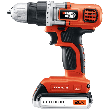Adding an Outdoor Receptacle
Written by Lee Wyatt (last updated December 7, 2018)
Have you ever noticed how often it seems like there aren't enough power receptacles that you can use outside your home? Often this can be accomplished by simply adding an outdoor receptacle. The task isn't particularly difficult, though it can take a novice up to six hours to accomplish. All you really need to do is follow these simple steps, and you will find yourself with a new outdoor electrical outlet that you can use.
One word of caution before you begin working on this project though. Make sure that you are familiar with your local ordinances and building codes. Some municipalities require than any electrical work be accomplished by a certified electrician, others may require a building permit, while still others may require both. You don't want to be working on a project, only to later find that you inadvertently broke the law.
Tools needed:
- Drill
- Long drill bit (wood and masonry)
- Saber saw
- Keyhole saw
- Hammer
- Cold chisel
- Lineman's pliers
- Screwdrivers (Philips and flat)
- Wire strippers
- GFCI power receptacle
- Cable with clamps
- Remodel box
- In-use cover
- Electrician's tape
- Wire nuts
Procedure:
- Decide on a location. Before you can begin adding a new outdoor receptacle, you will need to first find, and decide, on the location you are going to use. Try to decide on one that will be in an easily accessible location from the outside, as well as a corresponding outlet on the interior of the home.
- Shut off power. Once you have decided on the location of where you want the new receptacle you need to turn off the power to that section of the home. This will help protect you from accidental electrocution, and make the whole project a lot easier to accomplish. Test to ensure that the power is really turned off by plugging something into the receptacle inside the home, and seeing if it turns on. Turn the power off at the breaker box, and leave a note so that no one else will turn the power back on accidentally while you are working.
- Drill a hole. Take the cover off of the interior receptacle, and then detach the receptacle. Use a long drill bit, and drill a guide hole to the outside of the home. If the exterior of the home is some kind of masonry, then you should use a masonry bit to get through the brick. Drill the hole at a bit of an angle, just to make sure that there is enough of space to place a new receptacle box.
- Cut a hole. Find the guide hole on the outside of the home, and drill a second hole. This second hole can be used as an entry hole for your saber saw or keyhole saw. In the event that the exterior of the home is some kind of masonry, then you will need to use a masonry saw to cut through the exterior. This hole should be slightly larger than the receptacle that you will be installing. Proceed to install the receptacle.
- Run your cable. Cut your cable about two to three feet longer than you are going to need, and then strip the ends. Stripping the ends means that you remove the protective sheathing from wiring. Attach the cables to the wiring studs, and then have a friend help push the cables through the holes to the new receptacle.
- Install a cover. Install an in-use cover over the receptacle. This type of cover allows you to close it, and then lock it shut even when a cord is plugged in. To help provide a tight seal install some rubberized gaskets behind the plates.
- Test your work. Turn the power back onto that section of the home, and then plug something into the new receptacle. If the power is working properly, then the item that you plugged in will work as it is designed. Congratulations, you have completed your task.
Author Bio
Lee Wyatt
Contributor of numerous Tips.Net articles, Lee Wyatt is quickly becoming a regular "Jack of all trades." He is currently an independent contractor specializing in writing and editing. Contact him today for all of your writing and editing needs! Click here to contact. Learn more about Lee...
Cleaning a Gas Range
I may have been living under a rock, but to me it appears that gas ranges are popping up all over the place. After all, ...
Discover More
Caring for Potted Rose Plants
There are a variety of reasons that people choose to place their rose plants into pots or other kinds of containers. ...
Discover More
Teaching Cats Boundaries
Despite what many people would like to think, it is possible to train a cat. Not only is it possible, you should take the ...
Discover More
More Home Improvement Tips
Installing Motion-Sensor Lights
Safety is always an important issue to homeowners, and there is almost always something that can be done to improve it ...
Discover More
Replacing a Dimmer Switch
Dimmer switches can be very helpful in creating a soothing atmosphere or an alert atmosphere, all at the twist of a knob. ...
Discover More
Replacing a Three-Way Switch
Chances are you may have a three-way switch in your home without even realizing it. Three-way switches are those light ...
Discover More

Comments